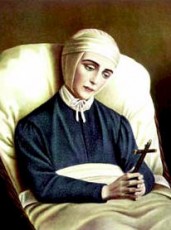Catholic Blesseds, Saints, Solemnities & Holy Days

Blessed Anne Catherine Emmerich
Feast Day: February 9
Patronage: Sufferers of illness, spiritual enlightenment
Blessed Anne Catherine Emmerich (1774–1824) was a German Augustinian nun, mystic, and stigmatist renowned for her profound spiritual experiences and vivid visions of Christ’s life, Passion, and the lives of saints. Born into a devout peasant family, Anne Catherine demonstrated exceptional piety and mystical gifts from an early age. Despite enduring tremendous physical suffering, she remained steadfast in her mission to unite her pain with Christ’s Passion for the redemption of souls. Her life continues to inspire believers to trust in God’s will, even in the midst of suffering.
Anne Catherine Emmerich’s journey into a life of profound faith and suffering began in her small farming village in Westphalia, Germany. From a young age, she felt drawn to the Church, often spending hours in prayer despite her family’s poverty. When she finally entered the Augustinian convent in Dülmen at the age of 28, she embraced her calling with great joy. However, her path was anything but easy.
In 1813, illness rendered Anne Catherine bedridden, and she soon began to bear the stigmata—the wounds of Christ’s Passion—on her body. These visible signs of her union with Christ attracted both pilgrims and skeptics. Though her suffering was immense, she embraced it as a means of offering herself for the salvation of others. Her bed became a place of pilgrimage, where countless people sought her prayers and guidance.
Anne Catherine’s visions, recorded by poet Clemens Brentano, brought the Gospels to life with vivid, detailed accounts of Christ’s Passion, the lives of the apostles, and even scenes from the Old Testament. One striking moment came when she described the location of the Virgin Mary’s house in Ephesus—long before its archaeological discovery. Despite the skepticism she faced, Anne Catherine remained humble, insisting that all glory belonged to God.
Her story is a powerful example of turning pain into purpose. For leaders and individuals alike, her life teaches us to embrace challenges as opportunities for spiritual growth, reminding us that faith can transform even the heaviest burdens into profound acts of love and service.





